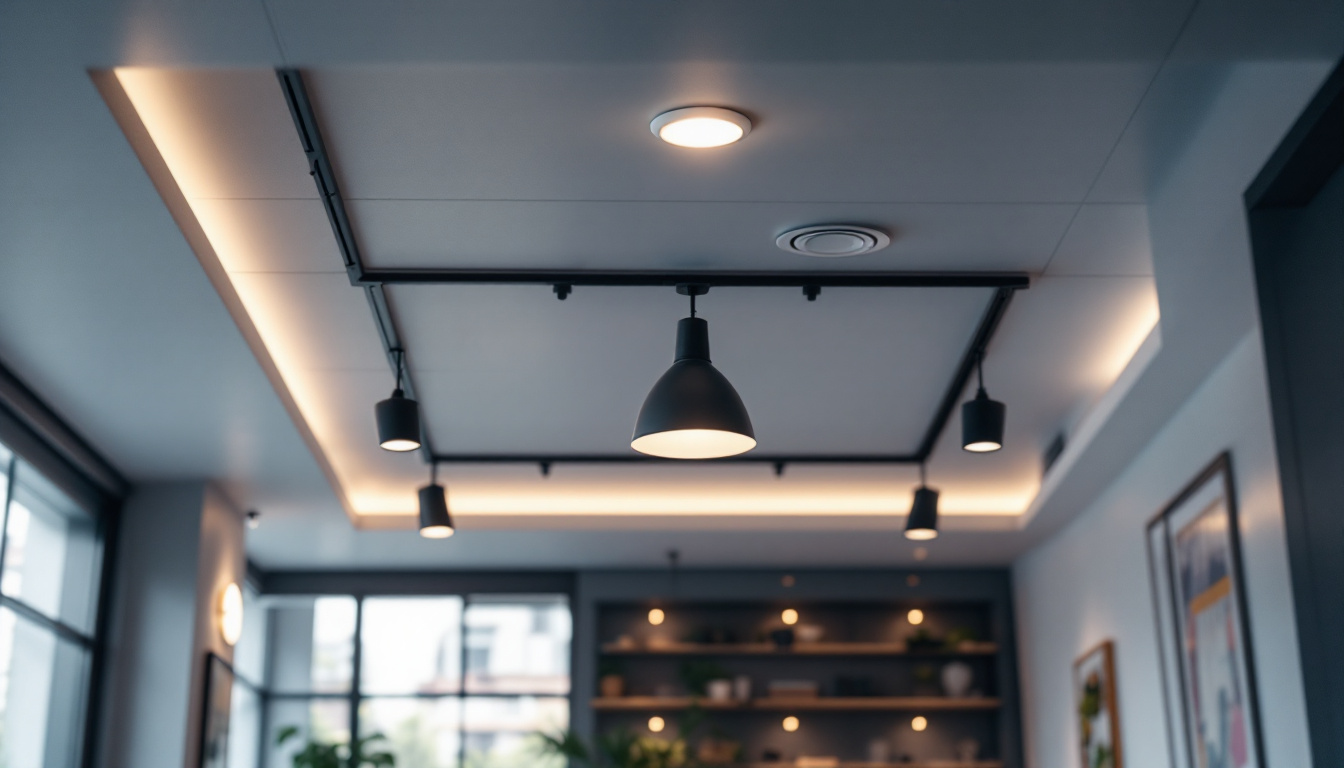

drop ceiling can lights, also known as recessed lights or pot lights, have become increasingly popular in modern interior design. These fixtures offer a sleek, unobtrusive way to illuminate spaces, making them ideal for both residential and commercial applications. For lighting contractors, understanding the intricacies of drop ceiling can lights is essential for delivering quality installations that meet client expectations. This article delves into the various aspects of drop ceiling can lights, covering their benefits, installation processes, types, and considerations for optimal performance.
Drop ceiling can lights are recessed lighting fixtures designed to be installed into a drop ceiling grid. Unlike traditional light fixtures that hang from the ceiling, these lights are installed above the ceiling tiles, providing a clean and modern look. The design allows for even light distribution, enhancing the overall ambiance of a room while minimizing visual clutter.
These fixtures come in various sizes and styles, allowing for customization based on the specific needs of a space. They can accommodate different types of bulbs, including LED, incandescent, and fluorescent options, each offering unique benefits in terms of energy efficiency, brightness, and color temperature. For instance, LED bulbs are particularly favored for their longevity and low energy consumption, making them an environmentally friendly choice that can significantly reduce electricity bills over time.
One of the primary advantages of drop ceiling can lights is their ability to create a seamless appearance in a room. By being flush with the ceiling, they draw attention away from the light fixture itself and focus on the overall design of the space. This is particularly beneficial in areas where aesthetics are crucial, such as offices, retail spaces, and homes. Moreover, their unobtrusive design means they can blend into various interior styles, from minimalist to industrial, without overwhelming the decor.
Additionally, these lights provide excellent flexibility in terms of placement. They can be strategically positioned to highlight specific areas, such as artwork or architectural features, or to provide general ambient lighting. This versatility makes them a popular choice among lighting designers and contractors. Furthermore, with advancements in smart lighting technology, many drop ceiling can lights can now be integrated into home automation systems, allowing users to control brightness and color temperature through mobile apps or voice commands. This not only enhances convenience but also enables users to create dynamic lighting scenes that can adapt to different activities or moods throughout the day.
Standard recessed lights are the most common type of drop ceiling can lights. They typically consist of a housing unit, a trim, and a light bulb. The housing is installed above the ceiling tiles, while the trim is visible from below. These lights are available in various sizes, with the 4-inch and 6-inch models being the most popular.
Standard recessed lights can accommodate different types of bulbs, allowing for a range of brightness and color temperatures. This adaptability makes them suitable for various applications, from task lighting in kitchens to ambient lighting in living rooms.
Adjustable recessed lights offer the added benefit of directional lighting. These fixtures can be tilted or rotated, allowing contractors to direct light where it is needed most. This feature is particularly useful in spaces with artwork or architectural elements that require focused illumination.
Adjustable can lights are often used in commercial settings, such as galleries and showrooms, where highlighting specific products or features is essential. They can also be beneficial in residential spaces, providing versatility in lighting design.
LED recessed lights have gained popularity due to their energy efficiency and long lifespan. These fixtures use significantly less energy than traditional incandescent bulbs, making them an environmentally friendly choice. Additionally, LED lights produce less heat, reducing the load on HVAC systems and contributing to overall energy savings.
With advancements in LED technology, these lights are now available in a variety of color temperatures, allowing for greater customization in lighting design. From warm white to cool daylight, contractors can select the perfect LED bulb to match the desired ambiance of a space.
Before starting the installation of drop ceiling can lights, thorough planning is essential. Contractors should assess the space to determine the optimal placement of the fixtures, taking into consideration factors such as ceiling height, room size, and the intended use of the space. It’s also important to create a lighting layout that ensures even illumination throughout the area.
Once the layout is finalized, contractors should gather all necessary tools and materials, including the can lights, wiring, electrical boxes, and any additional components required for installation. Ensuring that all materials are on hand before beginning the installation can help streamline the process.
The installation of drop ceiling can lights involves several key steps. First, the contractor must remove the ceiling tiles in the designated areas where the lights will be installed. This may require cutting the tiles to fit around the housing of the can lights.
Next, the housing units are installed above the ceiling tiles. This typically involves securing the housing to the grid system and ensuring that it is level. Once the housing is in place, the contractor will run electrical wiring to each fixture, connecting them to the power source.
After the wiring is complete, the contractor can replace the ceiling tiles, ensuring that the trim of the can lights is flush with the ceiling. Finally, the appropriate bulbs are installed, and the lights are tested to ensure proper function.
The choice of bulb is a critical factor in the performance of drop ceiling can lights. Contractors should consider the brightness (measured in lumens), color temperature (measured in Kelvin), and energy efficiency of the bulbs being used. For instance, a warm white bulb may create a cozy atmosphere in a living room, while a cool daylight bulb may be more suitable for task-oriented spaces like kitchens or offices.
Additionally, it’s important to ensure that the bulbs are compatible with the fixtures being installed. Some recessed lights are designed specifically for LED bulbs, while others may accommodate a range of bulb types. Understanding these specifications can help contractors avoid issues during installation.
Proper spacing between drop ceiling can lights is essential for achieving even illumination. As a general rule, lights should be spaced approximately 4 to 6 feet apart, depending on the height of the ceiling and the desired level of brightness. In areas with higher ceilings, contractors may need to increase the spacing to avoid creating dark spots.
In addition to horizontal spacing, contractors should also consider the distance from walls. A common guideline is to position lights about 1.5 to 2 feet away from walls to prevent harsh shadows and ensure a balanced lighting effect.
In residential settings, drop ceiling can lights can enhance the aesthetic appeal and functionality of various rooms. In kitchens, they provide task lighting for food preparation, while in living rooms, they create a warm and inviting atmosphere. Bedrooms can also benefit from recessed lighting, allowing for adjustable brightness levels to suit different activities.
Many homeowners appreciate the versatility of drop ceiling can lights, as they can be used in conjunction with other lighting sources, such as pendant lights or wall sconces, to create layered lighting designs. This flexibility allows for a more dynamic and visually interesting space.
In commercial environments, drop ceiling can lights are often used to create a professional and polished appearance. Offices, retail stores, and restaurants can all benefit from the clean lines and unobtrusive nature of recessed lighting. These fixtures can be strategically placed to highlight products, create focal points, or provide general illumination.
Moreover, energy-efficient options like LED recessed lights are particularly appealing for businesses looking to reduce operational costs. By installing energy-efficient lighting, companies can not only save on electricity bills but also contribute to sustainability efforts.
While installing drop ceiling can lights can be straightforward, several challenges may arise. One common issue is dealing with existing infrastructure, such as ductwork or plumbing, that may obstruct the installation of the housing units. In such cases, careful planning and creativity may be required to find alternative solutions.
Another challenge is ensuring proper electrical connections, especially in older buildings where wiring may not meet current standards. Contractors must be diligent in assessing the existing electrical system and making any necessary upgrades to ensure safety and compliance.
Lighting quality can also be a concern when installing drop ceiling can lights. Issues such as flickering lights, inadequate brightness, or uneven illumination can detract from the overall effectiveness of the lighting design. To address these issues, contractors should ensure that they are using compatible bulbs and fixtures, as well as following best practices for spacing and placement.
Additionally, incorporating dimmer switches can provide further control over the lighting quality, allowing users to adjust brightness levels based on their preferences and activities.
Drop ceiling can lights are an excellent choice for both residential and commercial applications, offering versatility, aesthetic appeal, and energy efficiency. For lighting contractors, understanding the various types of fixtures, installation processes, and considerations for optimal performance is crucial for successful projects. By staying informed about the latest trends and technologies in lighting, contractors can provide clients with innovative solutions that enhance their spaces while meeting their functional needs.
As the demand for modern lighting solutions continues to grow, drop ceiling can lights will undoubtedly remain a popular choice for creating beautifully illuminated environments. Embracing this trend can lead to satisfied clients and successful installations, making it a valuable addition to any contractor’s repertoire.
Ready to elevate your lighting installations with the sleek appeal of drop ceiling can lights? At LumenWholesale, we offer an extensive selection of spec-grade lighting products that combine quality with unbeatable wholesale value. Say goodbye to inflated markups and hello to premium lighting solutions that fit your project’s needs and budget. With free shipping on bulk orders, you can trust us to provide the high-performance lighting you require, without any hidden fees. Don’t compromise on quality or cost—choose LumenWholesale for Wholesale Lighting at the Best Value and light up your space with confidence.

Discover essential tips and strategies for lighting contractors to prevent common pitfalls when working with LED light poles.

Discover how modern industrial lighting can transform your space, offering both functionality and style.

Discover the key challenges lighting contractors face when working with 12,500 lumen LED lamps.

Discover the hidden pitfalls of purchasing electrical supplies and mounting kits in bulk from local distributors.
Get notified when NEW deals are released.
Optimize your budget with wholesale discounts.
Only top-quality, specification-grade lighting products.
No additional costs at checkout - what you see is what you pay.
We understand the unique needs of contractors.